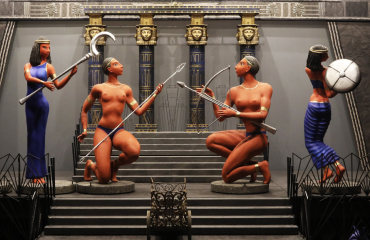Erarta Museum presents an exhibition by Yekaterinburg artist Kirill Borodin, who acutely perceives and cleverly reflects life in the digital age
- Irony and sarcasm in the ultra-modern painting style
- Socialites and their Pomeranians
- Harsh reality behind the glossy façade
The name of Kirill Borodin is new for the Petersburgers since the artist lives and works in Yekaterinburg. Similarly to the characters of his own works, the artist is young, handsome and successful. At first glance, his paintings seem glossy and positive; and yet, the closer inspection reveals under Kirill Borodin’s ultra-modern style the deepest irony and subtle sarcasm.
“The Garden of Delights” series presents a character, who is certain that being a woman is an achievement in itself. One can put the blame for such worldview on the pop culture with its music industry, social media, bloggers and “How to do nothing and marry a millionaire” trainings.
Hip Hop and R’n’B culture endlessly exploits the image of an outgoing sexy beautiful girl, the majority of music videos preach the pleasures of life and glorify the body as an object of sexual desire. Today even the most lustful men complain about the stream of aggressive female sexuality flowing from the music channels that makes them fear potential impotence. Don’t get me started on the beauties over the age of 30, who develop depression due to their own “imperfection”!
The artist’s heroes embody a stereotypical image of a “blonde”, of an active fashionable young woman, who sees a successful marriage as the culmination of her development. A viewer unmistakably recognizes the typicality of their appearance: the body of a model, long straightened hair, indifferent facial expression, and fur vests that quite recently were trendy. These beauties squeeze their miserable Pomeranians and take them in their bags to the night clubs, treating those dogs as the accessories rather than the living creatures.
Unlike his characters, Kirill Borodin understands that the glamorous façade masks the harsh reality. The basic instincts, sedated by the comfort of the city life and surrounded by the surrogate nature in the form of decorative cats and dogs, are still at work. The artist expresses their spontaneous awakening through the scenes of the fierce battles between the poms and the Chihuahuas and the altercations between the “living dolls”, which exposes the modern life in its superficiality, megalomania and imaginary invulnerability.
The artist finds another powerful source of inspiration in the social media, where we endlessly advertise ourselves via selfies. By presenting themselves to the world through the front camera, people grow to understand and perceive themselves through the followers’ feedback. Many have made the social networks their job; people blindly follow the bloggers and, subsequently, the real life starts to seem too complicated and the mind grows more infantile, while the critical thinking completely disappears. Kirill Borodin’s work “Rubber Friend” illustrates the issue in the most comprehensive way. A company asked a blogger to advertise their produce, namely, a swim ring in the shape of a pink flamingo. Upon the blogger’s publication, the trend was picked up by the hundreds of users; the artist, with humor, captured this bizarre fashion on his canvas.
Kirill Borodin plays the same trick on a viewer as the social networks do: many of his paintings are reminiscent of the Instagram photos made at the most favorable moments of life from the best angle.
A closer look at the artist’s works makes you realize that the author relies on the classical iconic stories. For instance, in “Rubber Friend”, one can decipher a reference to the Ancient Greek myth about Leda and the swan, while the baroque composition of the “Naughty Cat” evokes the Rembrandt’s masterpiece “The Sacrifice of Abraham”; the dynamics and the position of the figures in “Showdown on the Outskirts of Town” are based on the classic examples of the military art such as “The Battle of San Romano” by Paolo Uccello.
Moving from the subjects to the style of painting, it should be noted that the artist paints with ease; his realism is characterized by the energetic brush strokes and colours; the drawing is anatomically convincing, which, in our day, constitutes an achievement. The artist works and thinks a lot, and that is why his glossy philosophical style constantly expands its borders, endlessly developing the old themes and generating the new ones.











